
Cooking seafood at home can be intimidating. At least, it has been for me. And yet, whenever I’ve pushed myself to try a new recipe, I’ve been well-rewarded. It’s something I’d like to include more in our meals.
We’re lucky to have an incredible family-owned and operated grocery—Nugget Markets—right around the corner, with knowledgable fishmongers who are happy to help in this regard. We will again be partnering on a series of posts this year so, to start, I asked if I could visit the seafood department to get some advice about how we can all have more confidence when it comes to choosing the best fish and preparing it at home.
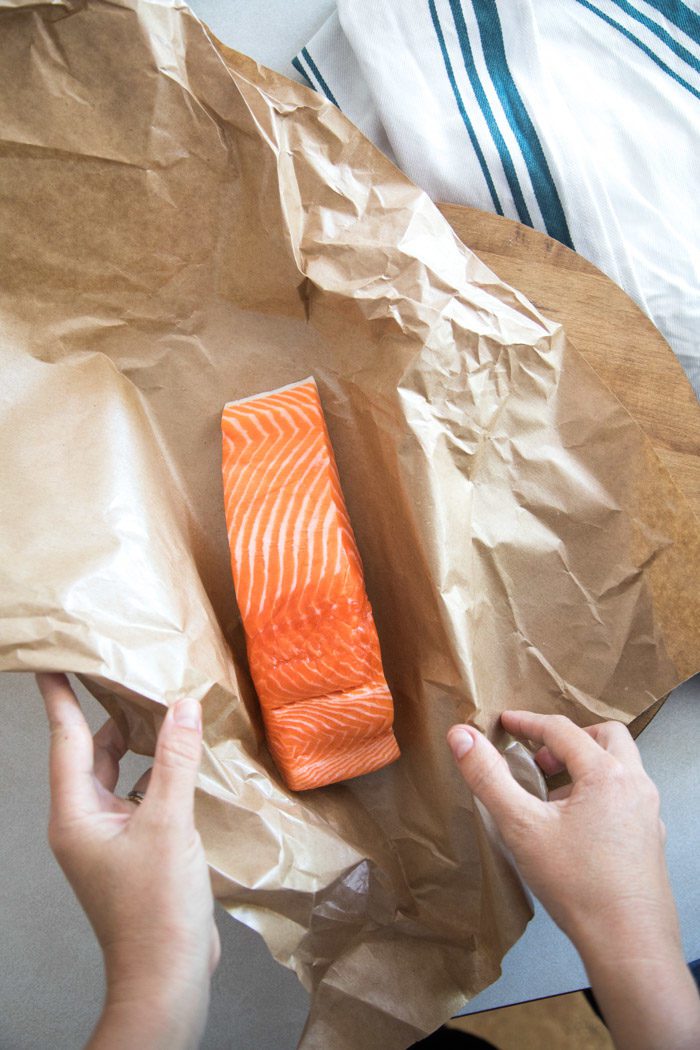
What I’ve learned in the process is that the surest way to get a delicious result is to start with quality, fresh fish. There are three main factors to consider:
First, when it comes to freshness, the place you buy your fish matters! Nugget Markets, I learned, receives fresh seafood deliveries six days a week, and is in constant contact with their supplier so that they only order as much as they can sell that day. Ask your local store about their delivery schedule. Seafood is the most perishable item in the store, and they should be willing to run out of something rather than overstock a display.
Second, shopping day is (ideally) cooking day. If you’re not cooking your seafood the day you purchase it, you can store it in portions in a sealed bag with the air pushed out in your fridge for up to 3 days. Some recommend placing ice on top (being careful not to let the water touch the fish). Freezing should be a last resort.
If you have a specific recipe you’re hoping to follow for dinner, bring it in to the market. If the fish you had in mind is unavailable—perhaps it’s out of season—a good fishmonger can suggest an alternative. They may even be able to give you some cooking tips—or season a fillet for you!
Third, sustainability counts. When you purchase seafood that is sustainably farmed or harvested, you are supporting things like: biodiversity, habitat health (clean oceans and land), and the livelihood of fishing communities.
Your fishmonger should be informed and able to explain the impact of their products. Nugget Markets follows Best Aquaculture Practices and partners with FishWise, a non–profit, science–based, sustainable seafood labeling program that incorporates green, yellow and red color designations indicating whether sources are well-managed and caught or farmed in environmentally responsible ways. The labels also tell the origin of the fish and the catch method. I was interested to learn that wild-caught seafood is not necessarily better than farmed seafood, or vice versa. It depends entirely on case–by–case basis assessments.
I’m happy to say that Nugget tries to carry all green and yellow labels—and little to no red (which means that the seafood is over-fished and/or its farming or catch method is damaging to the environment).
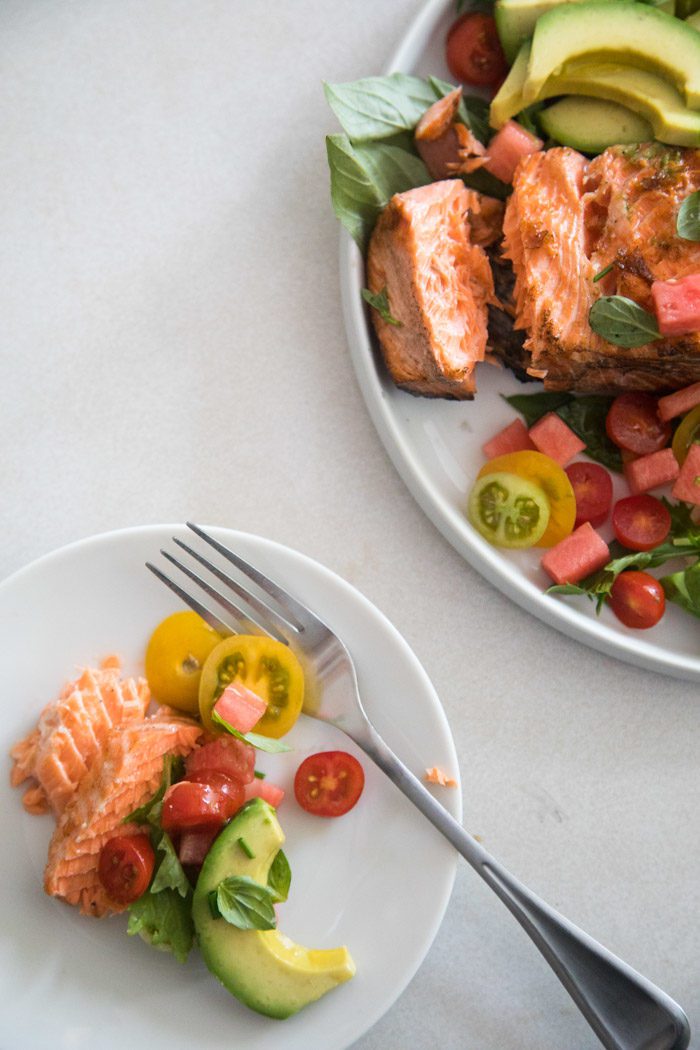
Of course this doesn’t address what’s perhaps the most common home-cook question (and fear): How do I avoid making my house smell like fish?
The simplest answer? Cook it outside! Here’s a recipe for grilled Salmon that’s perfect for making outside this summer…
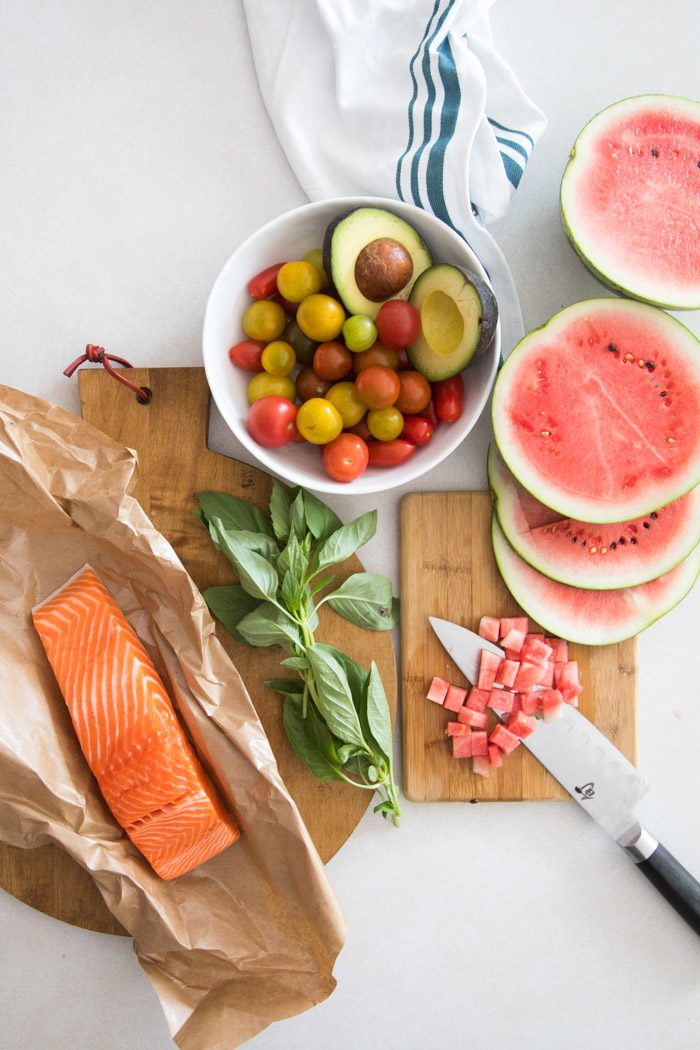
Grilled Salmon with Basil, Watermelon & Tomatoes
Now through the end of summer is peak season for wild Salmon—King, Sockeye, Coho, etcetera; you can also find a green-labeled King Salmon, branded Ora, that’s farmed in New Zealand year round.
Ingredients, per person:
6-8 ounces of Salmon filet, with skin on
A handful of cherry tomatoes, sliced in half
Half a dozen leaves of fresh Basil
Half an avocodo, sliced
A slice of watermelon, cubed
Extra Virgin Olive Oil
Salt and Pepper to taste
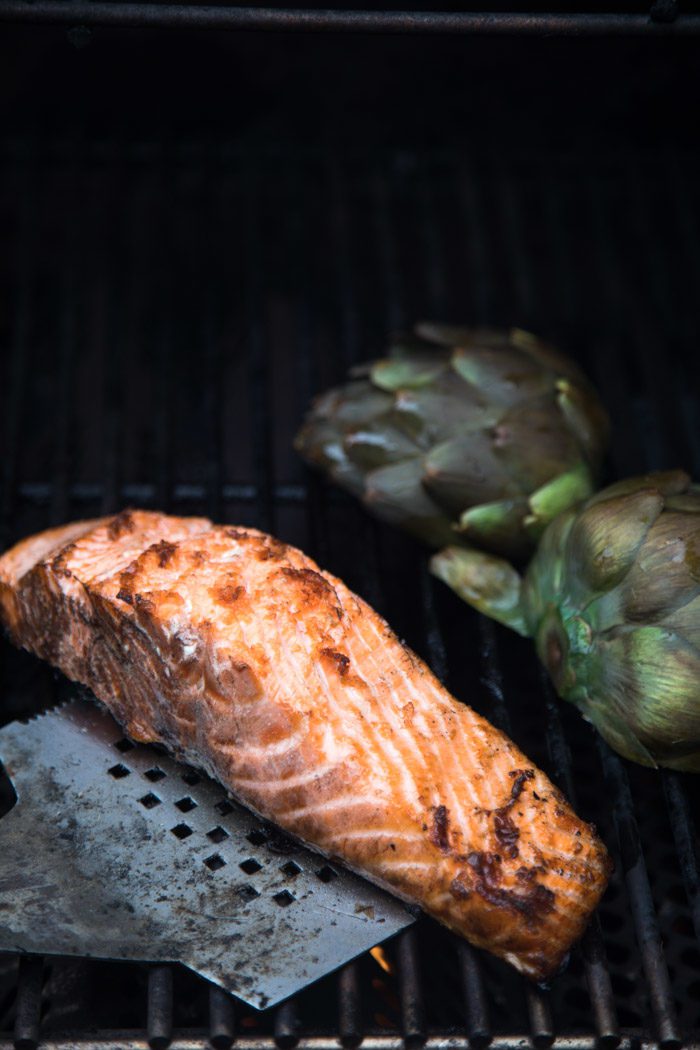

How to make:
Heat your grill, getting it very hot before you start. Brush both your grill and the fish with olive oil to prevent sticking.
Season the fish with salt and pepper.
Place the fish skin side down on the grate. Cook salmon for about 5 to 6 minutes, then flip. If the fish is sticking to the grill grate, then it’s not ready to flip.
Cook for another 3 to 10 minutes, depending upon how hot your fire is. Salmon, like tuna, can be enjoyed when it’s still on the rare side in the middle, with a crisp exterior. Just how rare is a matter of personal preference. If you are using a thermometer, America’s Test Kitchen recommends removing the fish once it reaches 125F. Note: White beads of sweat are a sign of overcooking.
Assemble a salad of all of your ingredients and serve the salmon atop. Finish with olive oil and season with additional salt and pepper as needed.
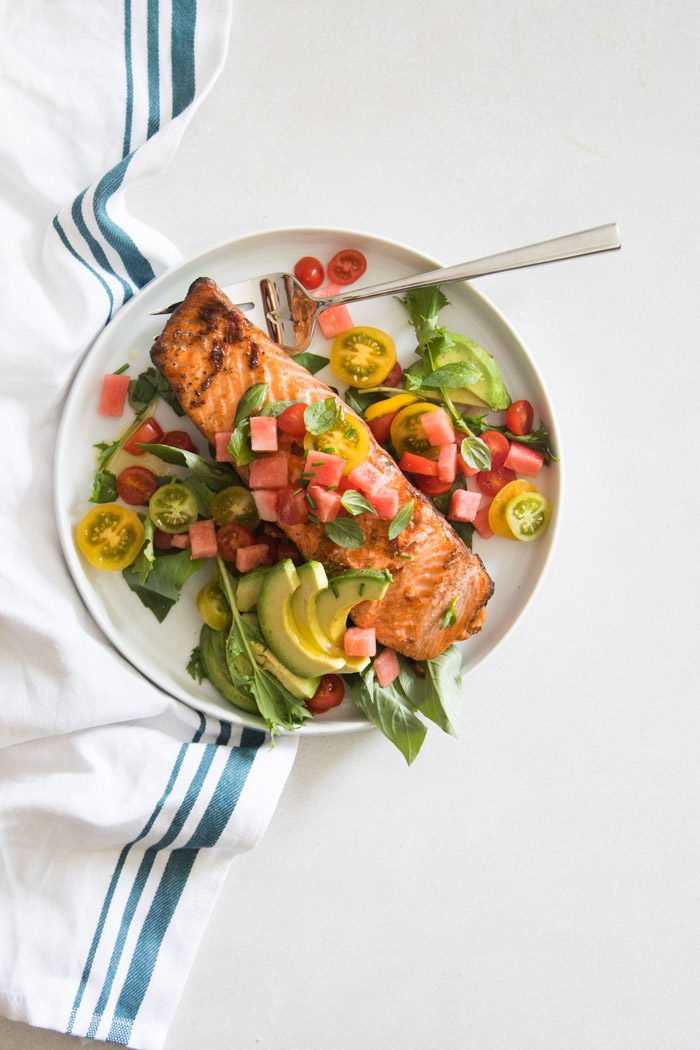
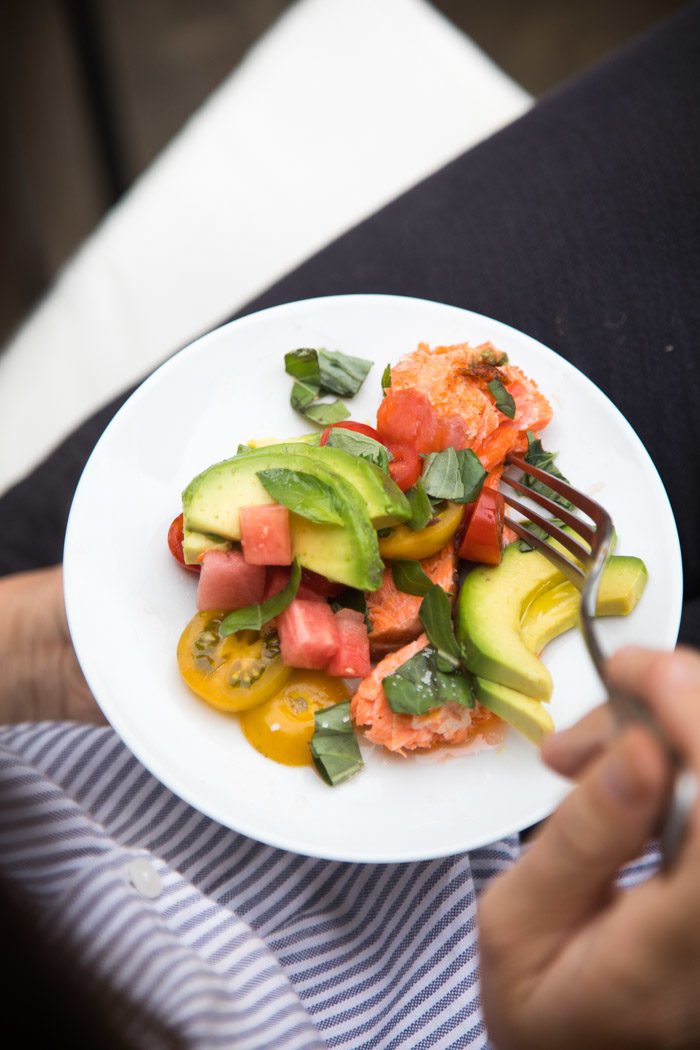
Serve warm and enjoy! The sweet watermelon and the acid of the tomatoes come together in a wonderful expression of the season, while still letting the fish shine through.
How do you like to prepare fish? Do you cook seafood at home?
This post is sponsored by Nugget Markets, our local, family-owned grocery. Founded in 1926, Nugget Markets has been committed to providing an extensive selection of quality products, exceptional service and lower prices than any other conventional grocery store. Their house Fresh to Market label focuses on products developed in partnership with local producers, and while their stores are currently only to be found in Sacramento Valley and in Marin County, their focus on the local and seasonal is an ethos one can seek out anywhere.
And for 12 consecutive years, Nugget Markets has claimed a spot on Fortune Magazine’s “100 Best Companies to Work For” list. I’m honored to partner with them! Moreover, thank you specifically to Bill Davis and the seafood department at my local Nugget Markets for showing me my way around the fish selection process.
P.S. Summer tartines and frozé


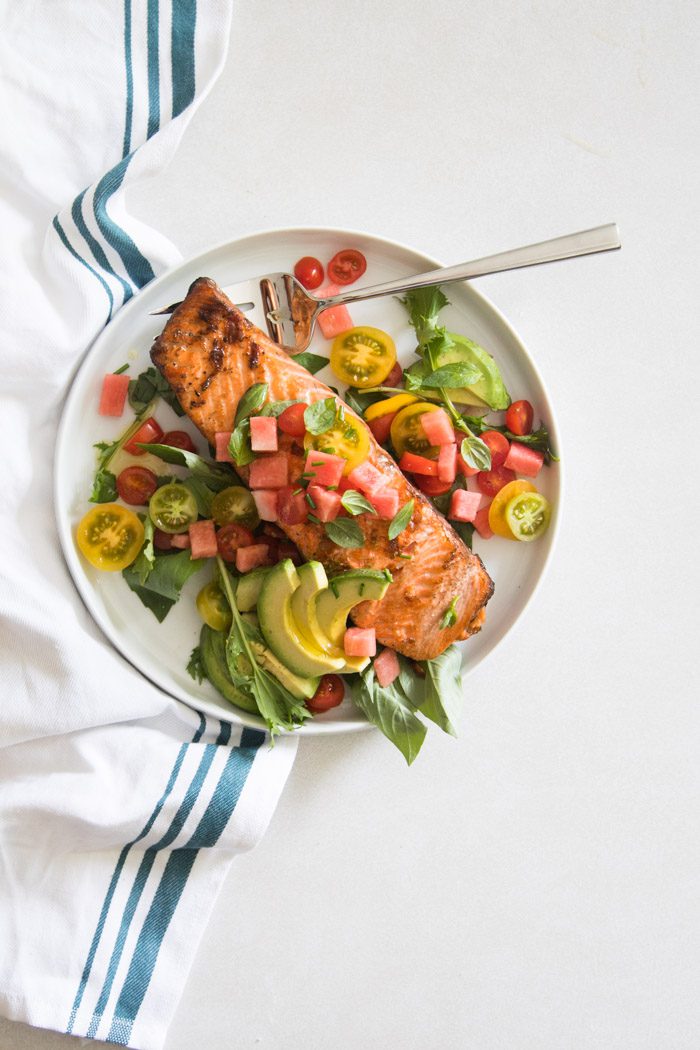


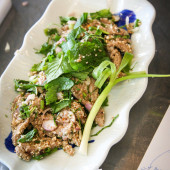











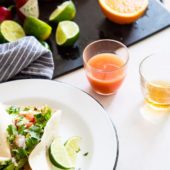




















12 Comments